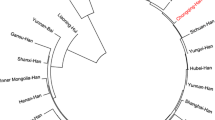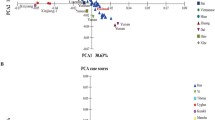Abstract
The genetic polymorphisms of 15 autosomal short tandem repeat (STR) loci included in the AmpFlSTR®Sinofiler™ kit were evaluated from 508 unrelated healthy individuals of the Lisu ethnic minority living in Chuxiong Yi Autonomous Prefecture, Yunnan province, southwest of China. Fourteen of the 15 loci reached the Hardy–Weinberg equilibrium after Bonferroni correction. These loci were examined to determine allele frequencies and forensic statistical parameters. The genetic relationship between the Lisu population and other Chinese populations were also estimated. The combined discrimination power and probability of excluding paternity of the 15 STR loci were 0.999 999 999 999 999 999 654 and 0.999 998 882, respectively. These results suggest that the 15 STR loci are highly polymorphic, which is suitable for forensic personal identification and paternity testing.
Similar content being viewed by others
References
Cang M (1997) On the migration culture of the ethnic groups in Yunnan. The Nationalities Publishing House of Yunnan, Kunming
Walsh PS, Metzger DA, Higuchi R (1991) Chelex 100 as a medium for simple extraction of DNA for PCR-based typing from forensic material. Biotechniques 10:506–513
Bar W, Brinkmann B, Budowle B, Carracedo A, Gill P, Lincoln P, Mayr W, Olaisen B (1997) DNA recommendations. Further report of the DNA Commission of the ISFH regarding the use of short tandem repeat systems. International Society for Forensic Haemogenetics. Int J Legal Med 110:175–176
Zhao F, Wu X, Cai G, Xu C (2003) The application of Modified-Powerstates software in forensic biostatistics (in Chinese). Chin J Forensic Med 18:297–298
Excoffier L, Lischer HE (2010) Arlequin suite ver 3.5: a new series of programs to perform population genetics analyses under Linux and Windows. Mol Ecol Resour 10:564–567
Retief JD (2000) Phylogenetic analysis using PHYLIP. Methods Mol Biol 132:243–258
Tamura K, Stecher G, Peterson D, Filipski A, Kumar S (2013) MEGA6: molecular evolutionary genetics analysis version 6.0. Mol Biol Evol 30:2725–2729
Poetsch M, Bajanowski T, Pfeiffer H (2012) The publication of population genetic data in the International Journal of Legal Medicine: guidelines. Int J Legal Med 126:489–490
Acknowledgements
We would like to thank the donors who contributed samples for this study. This work was supported by grants from the Natural Science Foundation of China (81860258,31660310,31860300), the Science and Technology Planning Projects of Yunnan Province (2017FE467(-022)), and the Yunnan Educational Science Foundation program (2018JS171,2018JS170).
Author information
Authors and Affiliations
Corresponding authors
Ethics declarations
Conflict of interest
The authors declare that they have no conflicts of interest.
Electronic supplementary material
Supplementary Figure 1
(DOCX 313 kb)
Supplementary Figure 2
(DOCX 17 kb)
Supplementary Table 1
(XLS 36 kb)
Supplementary Table 2
(XLS 29 kb)
Supplementary Table 3
(XLS 39 kb)
Rights and permissions
About this article
Cite this article
Zhang, X., Zheng, H., Liu, C. et al. Forensic features for Yunnan Lisu ethnic minority and phylogenetic structure exploration among 26 Chinese populations. Int J Legal Med 133, 103–104 (2019). https://doi.org/10.1007/s00414-018-1930-5
Received:
Accepted:
Published:
Issue Date:
DOI: https://doi.org/10.1007/s00414-018-1930-5




